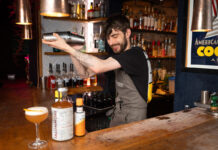A good range doesn’t have to include hundreds of bottles to prove popular

As the gin category has exploded, drinks companies have been quick to shout about the opportunities the spirit can bring to the on-trade.
But it can be tough to know how to get the offer just right with more products appearing every week and the category constantly expanding with new styles and flavours.
Fortunately, building a strong range of gins doesn’t all have to happen at once, and drinks companies advised that, for those who are still finding their feet, it can pay to start small.
“There’s no rule book here,” said Moira Swan, drinks buyer at wholesaler Inverarity Morton.
“It’s all about understanding your business and customers. Have some ‘names’, have a local gin, have a couple of interesting ones and build from there if you need to.”
Balancing recognised brand names with a selection of smaller craft products was also recommended by Amanda McLeod, marketing director at Hi-Spirits, distributor of gin brands including Blackwoods and Scapegrace.
“The key thing for operators to appreciate is that gin is no longer a ‘one-size-fits-all’ category,” she said.
“Stocking a range of brands covering mainstream, premium, local and craft gins will interest and engage customers, and with each gin having its own flavour profile.”
Not everyone will have space on the back-bar for hundreds of gins but, in a similar way to Scotch whisky, it’s said that bar and pub operators can cover a number of bases with just a few bottles.
Louis Wright, head distiller at Orkney Distilling, producer of the Kirkjuvagr range of gins, said: “Ensure you have a range of different regions of Scotland to make sure the entire country is represented but also vary the styles you have on offer, with classic, spiced, citrus or fruit flavoured, for example.
“Even with limited space on the gantry, you could have five or six different gins that meet these simple criteria.”
Wright was backed by Craig Innes of Pixel Spirits, maker of Devil’s Staircase.
“With limited gantry space, keep a core range of gins and then a secondary range which revolves to keep new and interesting products for your patrons,” said Innes.
Avoiding overlap was said to be important, particularly where space is limited.
“Avoid stocking several gins that sit in just one flavour category,” said Craig Harper, on-trade sales manager for mixer brand Fever-Tree.
“Offer a balanced list with about five gins that sit in each flavour profile, so you are catering for all tastes.”
With gin now encompassing a variety of different flavour styles, it can pay to ditch the traditional idea of having a ‘house’ spirit, according to James Porteous of Electric Spirit Co.
He said that if there is no house pour, “you’re more likely to spread people around the full range of gins you’re offering”.
Avoid stocking gins that sit in one flavour category. Offer a list that caters to all tastes.
Enthusiasm for the gins on the back-bar, and knowledge of what makes those gins unique, was another point stressed by drinks companies, and operators were advised to contact brands or suppliers for support.
“It is important to make contact with the individual brands who can always provide support, advice and often point of sale materials to assist them,” said Niall Macalister Hall of Beinn an Tuirc Distillers, producer of Kintyre Gin.
“Seek a wholesaler who has an excellent range, or go direct, but always take advice from others as to what is selling and why.”
Andrew Hannah, brand controller for Red Door Gin at parent company Gordon & MacPhail, agreed.
He said: “Having an understanding about where it’s from, how it’s made and what it tastes like is essential for today’s consumers who are looking for brands with a strong story and heritage.
“Operators can look for training sessions from the brand owners or their ambassadors, as well as referring to supplied training materials, brand websites and apps.”
Offering the right range of serves is another key piece of the gin puzzle, and drinks firms said there are a number of ways a menu can be used to encourage customers to try different gins.
Joanne Motion, UK customer marketing manager for Edinburgh Gin at parent company Ian Macleod Distillers, said: “Classic gin serves are still popular in the on-trade. However, consumers are also looking to operators for inspiration to explore the category.
“Encouraging customers to experiment with twists on classic combinations – such as a flavoured G&T or a gin Martini – is a fantastic way to maximise sales and drive customer satisfaction.”
This was supported by Bob Fowkes, co-founder and marketing director of Brockmans Gin, who advised operators to “experiment with a few classic cocktails, including a G&T properly made” as well as pairing gin serves with food.
Clearly, selecting the right tonics and mixers is an important aspect of any gin offer, and expectations on this front are high, said drinks firms.
“Consumers tastes are evolving and maturing – the increased popularity of flavoured gins means that selecting the correct tonic or mixer match is essential to the consumer experience,” said Emma Cotton, marketing director at Luscombe.
And Amy Burgess, senior trade communications manager at Coca-Cola European Partners, said there is a chance for operators to capitalise on a growing demand for “intriguing new tastes” by pairing gins with a range of different flavoured tonics, “paying special attention to particularly complementary flavours”.
In the age of social media, the way a drink is presented has become just as important as its ingredients, and operators were encouraged to make their serves as photogenic as possible.
Jen Draper, marketing director at Global Brands, the parent company of mixer brand Franklin & Sons, said the ideal on-trade gin serves should “look photo-ready for social media”.
This was backed up by research commissioned by the company, which found that members of “Generation Z” are more likely to order a drink if they’ve seen it on a bar’s Instagram page.
Garnishes tend to provide the finishing touch to a drink, and Carlo Valente of Boë Gin parent company VC2 Brands, said stocking a variety of citrus fruits, berries and edible flowers to use as garnishes is “essential”.



















